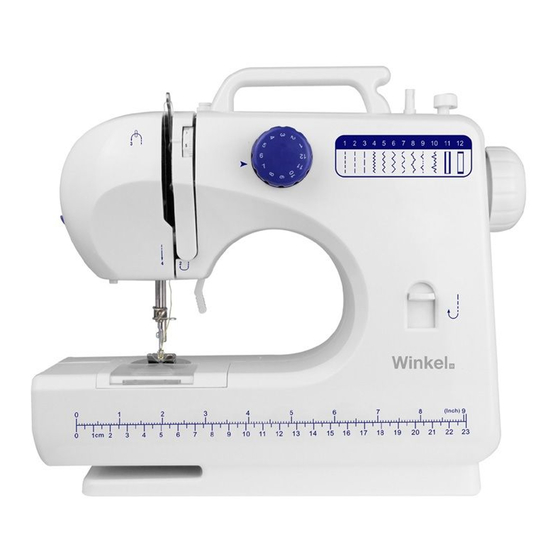
Table des Matières
Publicité
Les langues disponibles
Les langues disponibles
Liens rapides
Publicité
Table des Matières
Dépannage

Sommaire des Matières pour weasy SW45
- Page 15 FRANÇAIS Attention 1. Lisez ces instructions avant d´utiliser la machine. 2. Pour éviter l´électrocution, débranchez la prise avant de nettoyer la machine et après chaque utilisation. 3. Ne pas débrancher la machine en tirant sur le fil. Débrancher en tirant sur la fiche et non sur le fil. Cet appareil n'est pas destiné...
- Page 16 11. Ne cousez pas de matériaux trop élastiques. 12. Ne jamais utiliser cette machine à coudre si le câble d'alimentation ou la prise sont endommagés ou si son fonctionnement n'est pas normal, si elle est tombée par terre, dans de l'eau ou si elle a subi des dommages.
- Page 17 20. Vérifier que le voltage indiqué sur la plaque signalétique de l’appareil correspond bien à celui de votre installation électrique. Si ce n’est pas le cas, adressez-vous au revendeur et ne branchez pas l’appareil 21. Ne jamais laisser l’appareil sans surveillance lorsqu’il est en fonctionnement.
-
Page 18: Accessoires
Support de bobine Vue arrière Volant Support de canette Lampe Pied Pressoir Filtre Pédale Tiroir ACCESSOIRES Pédale ×1 Bobine de fil ×2 Canette ×2 Enfileur ×1 Aiguille(#14) ×1 Adaptateur ×1 BRANCHER LA MACHINE À COUDRE 1. CONNECTER le côté “A” à la machine et le côté “B” à la prise. 2. - Page 19 Méthode d´enfilage Pour enfiler la machine suivez les instructions suivantes: 1. Placez la bobine de fil sur le débobineur placer sur le dessus de la machine avec le fil sortant vers l´arrière de la machine, puis placez le stoppeur pour l´empêcher de sauter.
-
Page 20: Remplissage De La Canette
5. Une fois en bas l´aiguille va crocheter le fil du bas et le faire remonter (Img.5). 6. Sortez les deux fils d´environ 10 cm (Img.6). Attention: Il est impératif de bien enfiler le haut et le bas pour que la machine couse correctement, si vous voulez, vous pouvez faire un point de teste avant de commencer votre travail de couture. -
Page 21: Remplacement De L'aiguille
REMPLACEMENT DE L´AIGUILLE 1. Remontez l´aiguille à l´aide du volant. 2. Tenez l´aiguille pendant que vous dévissez l´écrou qui la maintien en place. Enlevez l´aiguille et disposez en convenablement pour éviter toute blessure. 3. Insérez la nouvelle aiguille la surface plate vers la droite avant de la fixer en place. 4. -
Page 22: Boutonnières
CARACTÉRISTIQUES SELECTION DE POINT Cette machine propose 12 points différents, 3 points droits, 7 zigzags et 2 points de resserrage de boutonnière. Référez vous au dessin sur la machine et sélectionnez le type de point souhaité avec la bobine de sélection de point comme montré sur l´image. - Page 23 CARACTERISTIQUES AJUSTER LE POINT 1. Comme montré sur l´image A, un point normal ne doit pas avoir de fils relaxés nis sur le dessus ni dessous. Top thread Cloth Bottom thread Img. A 2. Si le point du dessus est plat, le fil supérieur est trop tendu, vous devez tourner la bobine dans le sens des aiguilles d´une montre jusqu´à...
-
Page 24: Selection De La Vitesse De Couture
POINT INVERSE [ Vous pouvez utiliser le point inversé pour renforcer une couture, notamment au début et à la fin de celle-ci. 1. Renverser le point pour éviter que le point se détende. 2. Arrêtez de coudre, renversez le point puis commencez à coudre en point inversé Caractéristiques ZIGZAG 1. -
Page 25: Coupe Fil
TIROIR Tiroir pour le rangement des accessoires. COUPE FIL Un cutter est incorporé sur le côté gauche vous permettant de couper le fil. GUIDE DE DÉPANNAGE Problème Cause du Problème Réparation Pas de courant ou Piles installées incorrectement Réinstallez les piles la machine est lente Piles basses Utilisez de nouvelles piles... -
Page 26: Environnement
Fil bloqué sur la bobine Débloquez le fil Points relâchés ou supérieure irréguliers Fil trop tendu Aiguille casse Aiguille tordue Remplacez l´aiguille Pied pressoir trop relâché Replacez l´aiguille et resserrez le pied presseur Vous tirez trop sur le tissu Remplacez l´aiguille et renfilez avant de reprendre la couture en tirant le tissue doucement L´aiguille ne s´abaisse pas...